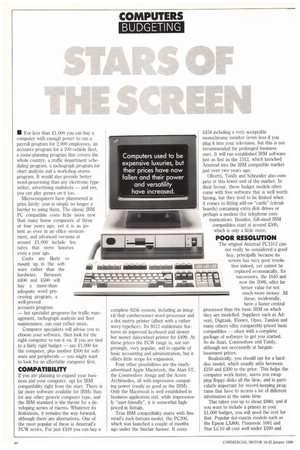• For less than 21,000 you can buy a computer
Page 42

If you've noticed an error in this article please click here to report it so we can fix it.
with enough power to run a payroll program for 2,000 employees, an accounts program for a 100-vehicle fleet, a route-planning program that covers the whole country, a traffic department scheduling program, a tachograph program for chart analysis and a workshop stores program. It would also provide better word-processing than any electronic typ( writer, advertising mailshots — and yes, you can play games on it too.
Microcomputers have plummeted in price lately: cost is simply no longer a barrier to using them. The classic IBM PC compatible costs little more now than many home computers of three or four years ago; yet it is as potent as ever in an office environment, and advanced versions at around £1,000 include features that were luxuries even a year ago.
Costs are likely to mount up in the software rather than the hardware. Between £400 and £500 will buy a more-thanadequate word processing program, a well-proved accounts program — but specialist programs for traffic management, tachograph analysis and fleet maintenance, can cost rather more.
Computer specialists will advise you to choose your software, then look for the right computer to run it on. If you are tied to a fairly rigid budget — say £1,000 for the computer, plus another £500 for software and peripherals — you might want to look for an affordable computer first.
COMPATIBILITY
If you are planning to expand your business and your computer, opt for IBM compatibility right from the start. There is far more software available for IBMs than for any other generic computer type, and the IBM standard is the theme for a developing series of micros. Whatever its limitations, it remains the way forward, although there are alternatives. One of the most popular of these is Amstrad's PCW series. For just £349 you can buy a
complete 8256 system, including an integral (but cumbersome) word-processor and a dot matrix printer (albeit with a rather wavy typeface). Its 9512 stablemate features an improved keyboard and slower but neater daisywheel printer for £499. At these prices the PCW range is, not surprisingly, very popular, and is capable of basic accounting and administration, but it offers little scope for expansion.
Four other possibilities are the muchadvertised Apple Macintosh, the Atari ST, the Commodore Amiga and the Acorn Archimedes, all with impressive computing power (easily as good as the IBM). Only the Macintosh is well established in business application and, while impressively "user-friendly", it is somewhat highpriced in Britain.
True IBM compatibility starts with Amstrad's rock-bottom model, the PC200, which was launched a couple of months ago under the Sinclair banner. It costs £458 including a very acceptable monochrome monitor (even less if you plug it into your television, but this is not recommended for prolonged business use). It will run established IBM software just as fast as the 1512, which launched Amstrad into the IBM compatible market just over two years ago.
Olivetti, Tandy and Schneider also compete at this lower end of the market. In their favour, these budget models often come with free software that is well worth having, but they tend to be limited when it comes to fitting add-on "cards" (circuit boards) containing extra disk drives or perhaps a modem (for telephone communication). Besides, full-sized IBM compatibles start at around £500, which is only a little more.
































































































